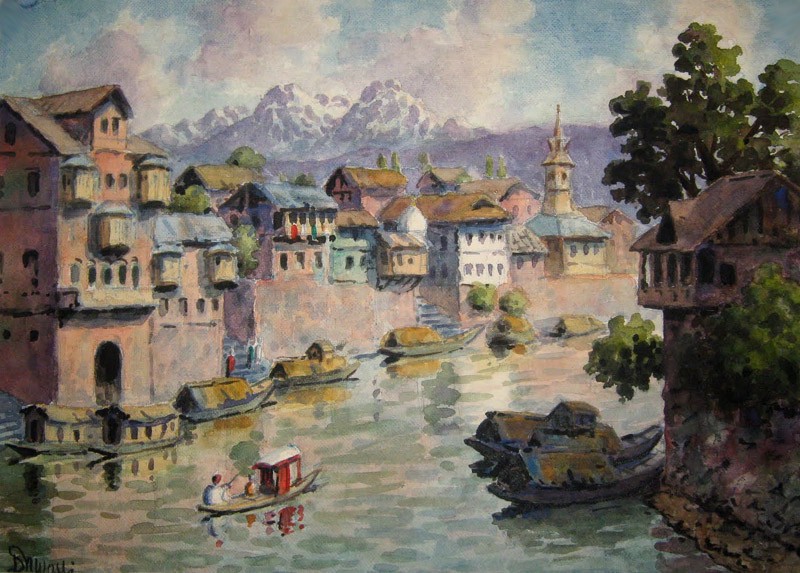In the theatre in Miami, Florida, where I saw The Kashmir Files, a tall young American man, a few rows down from us, let out a primal scream near the end of the movie and ran out.
He yelled he couldn’t take the pain, but he must have crept back in for I saw him as the movie ended.
It made me think of Ingmar Bergman’s Cries and Whispers, a film on the horrors of emptiness, loneliness, and death. Such pain is universally relatable but the idea that one’s neighbors and friends can be evil and perpetrate deceit, when most people are actually good, can be more frightening, and Vivek Agnihotri’s film takes on this subject.
The horror of the genocide of Kashmiri Hindus is a searing story. Compared to the genocide and sexual-slavery of the Yazidis, it is more terrifying psychologically, because while the Yazidis have returned home, the Kashmiris remain in perpetual exile. And in a diabolical twist, media accounts of the exodus made it out as if the Kashmiri Hindus had brought the tragedy upon themselves.
This movie has captured the public imagination for two main reasons. First, as an artistic creation of great merit and subtle balance; and second, for taking covers off the events that had been denied by India’s elites.
As artistic creation, it is a contrast from the mostly vacuous, algorithm-driven stuff Bollywood produces, with storylines copied from Hollywood but put together in the most inauthentic manner, using tired tropes of the stupid Hindu priest and the heartless Thakur.
The Kashmir Files is fresh and it doesn’t take the audience for granted. It has complex dialogue and nuanced characters, and the success of the movie shows that the audience is looking to go beyond the mind-numbing Bollywood offerings. It deals with the “raudra”, fearful, rasa, a very difficult aesthetic to enact. Without the raudra one cannot properly reach the state of kāruṇya, compassion.
For a long time, Indian audiences were patient with cleverly packaged, shallow stories so long they were good for whiling away a couple hours. At the end of the movie one didn’t remember or care what the story was.
This patience was a consequence of the hypocrisy and falsehoods that the Indian Left, which has controlled political and intellectual life in the country for decades, injected in entertainment, education, and journalism. This was done ostensibly to foster social amity but in truth to maintain control over institutions of power.
If several hundred thousand Kashmiri Hindus (called Pandits, or scholars, by the honorific granted to them by the early 18th century King Muhammad Shah of the Delhi court), were cleansed out of their homes, it was to be described as simply an exodus, a result of a conspiracy done by the governor of the State to malign the freedom campaign of Kashmiri Muslims. Truth was turned upside down.
Fake history
Indian schoolbooks teach white-washed or even false history, and since students can’t do anything about the books, they have learnt to go through the motions of the course and then forget the material.
The Left in India remains in a bubble, seeing India through the colonizer’s eyes. The British were in India for the publicly stated mission of civilizing the people, and debasing reason the Left has embraced this nonsense for truth.
The British destroyed India’s education and economy, “stole” 45 trillion pounds’ worth of wealth, precipitated devastating famines, and through their control of the education system somehow convinced Indians that it was all their fault.
The Left speaks of patriarchy in India but paints the West in glowing terms. For example, it doesn’t tell people about the estimated 3–5 million women who were executed or burnt alive as “witches” in Europe — women who resisted being cut them off from independent livelihood. It considers Indian culture regressive and ridicules Indian customs and festivals. It follows simple binaries: Hinduism is complex, immoral, and bad; later religions are simple, clear, and good.
Cancel culture may be new to the West, but it’s been practiced for decades by India’s self-hating, mind-colonized establishment, which has perpetuated stereotypes through schoolbooks, media and propaganda. As example of pervasive deceit, the Left swears by secularism but is happy that Hindu temples are administered by the State, whereas the religious places of other religions are free.
The genocide of Kashmiri Pandits was minimized by the Left because according to its ideology the Pandit beliefs are more regressive, and they were the wealthier group (although it wasn’t true), and so they deserved their fate.
The killings and the displacement of Kashmiri Pandits was a matter of shame for the government and their policy was to use the relatively benign euphemism of “exodus” for what had happened. The Kashmiri Pandit diaspora kept the story alive through meetings and seminars, and the pain of the expulsion from their ancestral home remains undiminished.
Religious war
In the 1980’s, Pakistan was the conduit for the flow of arms from the United States to the Taliban in Afghanistan that led to the defeat of the Soviets. Pumped up by this success, Pakistan stoked terrorism in the Punjab using Khalistani proxies, and they thought the time had come to snatch Kashmir from India.
Historians are aware that Pakistan sees itself as Riyasat-e-Medina, a temporary government (like the prophet’s) that will eventually conquer India as a part of Ghazwa-e-Hind, a prophecy of Jihad mentioned in sayings of Muhammad, foretelling battles in the Indian subcontinent resulting in the victory of Muslims over non-Muslims, as prelude to Qayamat, the Day of Judgment.
As a warlike religious state, it created laws against non-Muslims within the state, of which the most horrifying is the blasphemy law that lets a person abduct a girl from a minority religion, “convert” her so that she cannot return to her family and her religion for that would be blasphemy, and put her into sexual slavery, protected by this law.
The call for Ghazwa-e-Hind motivates the religious hardliner to keep military pressure on India and use all means, including terror, to achieve this goal. The background to the Hindu genocide in Kashmir was the weak Indian State of the late 80s pushed by an emboldened adversary.
Pakistani generals went along with this policy for they had not been held to account for the genocide in Bangladesh in 1971, in which the Pakistani Army and supporting Jamaat-e-Islami militias killed perhaps three million people and raped nearly half a million. The three million dead estimate from the Bangladesh government makes it the largest genocide since the Holocaust.
In December 1971, Pakistani Army surrendered to Indian forces. Of the 93,000 Pakistani POWs, 195 were suspected of committing war crimes. The appropriate course of action would have been to try them before an International War Crimes Tribunal. But the Indian government made a huge mistake and the war criminals and other POWs were released in April 1974.
This was a big moral lapse on India’s part. Pakistan concluded that criminal behavior had no consequences and this contributed to its use of terrorism in Punjab, Kashmir and elsewhere in India.
The recovery of memory
The Kashmir Files became a sensation as people realized that the terrible events of Kashmir from the 1990s have been hidden from the general public.
The geopolitical situation in the world has changed greatly from the 1990s. India is the world’s third largest economy based on PPP (purchasing power parity), and its economy is expected to become the world’s largest in the next 20 or 30 years. Indians individually have become extremely successful all over the world, and in the United States they represent the wealthiest ethnic group.
With economic success comes self-confidence. In the past, Indians used idealism or emotionalism to mask their weakness. There is recognition now that realism is the best policy in life and public affairs.
Even in questions related to conflict between communities, it is best to shine light on the past. Doing so generates wisdom to deal with similar conflicts in the future and perhaps avoid conflict altogether. There can be no real reconciliation without truth.
The Kashmir Files exposes layers of deceit within the ecosystem of Indian media, academic, and power establishments. An artistic creation becomes extraordinary if it takes the viewer from the immediate story to the dhvani of the universal. The movie is a story not just of Kashmir, but of our times, where deceit and hypocrisy lie just one layer below professions of justice and equality.
Vivek Agnihotri deals with the issue of evil that few artists have explored; this issue will become increasingly important over the world in the coming years, as jobs shrink due to AI and religious bigotry becomes intense.
But this is also a movie of hope for the truth has the potential to free both the perpetrator of injustice and the victim, to reveal common humanity, and to uncover ways to protect oneself from the evil that lies next to the truth.



![[ India Today ] Ohio senator JD Vance thanks wife, a Hindu, for helping him find Christian faith](https://hinduvishwa.org/wp-content/uploads/2024/06/us-senator-jd-vance-reveals-how-his-hindu-wife-usha-helped-him-find-his-christian-faith-image-re-272530504-16x9_0-120x86.webp)










